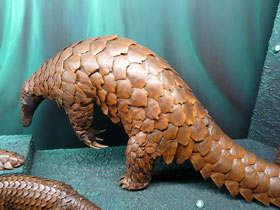The giant pangolin (Smutsia gigantea o Manis gigantea)
The giant pangolin (Smutsia gigantea) is a species of pangolins from genus Smutsia of subfamily Smutsiinae within the family Manidae. It is the largest living species of pangolins. Members of the species inhabit Africa with a range stretching along the equator from West Africa to Uganda. It subsists almost entirely on ants and termites.
Distribution
Smutsia gigantea or Manis gigantea is a species of folidot in the family Manidae.
Smutsia gigantea is a species of placental mammal of the order Pangolins (Pholidota). It is one of four species of lizards found in Africa, where it is found along the equator from West Africa to Uganda.
Smutsia gigantea lives in forests and savannahs where water and termites are abundant. They never climb to great heights.
Appearance
The exact body weight of Smutsia gigantea is unknown, but a Smutsia gigantea has been found to weigh 33 kg. Body length in males is about 140 cm, in females 125 cm. Smutsia gigantea is the largest species of pangolin, hence its name. Smutsia gigantea is covered with large, thick scales and has almost no hair (except for the eyelashes). The snout is long; the scales are usually brown or reddish brown. Long claws are present on the forelegs. The tail is long and broad.
Lifestyle and behaviour
Smutsia gigantea are usually solitary animals, but on one occasion a pair of Smutsia gigantea has been found digging with a young Smutsia gigantea. They can dig large, deep burrows, up to 40 m long and 5 m deep. The Smutsia gigantea is nocturnal and emerges from its burrow after midnight in search of food. Among the senses, the sense of smell is very well developed, as it plays an important role in the animal's life, and they have well-developed anal glands. The scent of these glands probably plays a role in intraspecific communication. When walking, most of the Smutsia gigantea's body mass is carried by its columnar hind legs. In doing so, the tail helps them to maintain their balance.
When Smutsia gigantea is surprised by a predator, it starts to hide its head between its front legs, thus exposing only its well-armoured shoulders to potential enemies. However, if the animal is touched or grabbed, it will curl completely into a ball. The needles on its tail are very sharp, so Smutsia gigantea can use them as a weapon.
Nutrition and reproduction
Smutsia gigantea feeds on ants and termites. Termite burrows are opened with its powerful claws. Smutsia gigantea can eat a large number of these animals. Smutsia gigantea also needs constant access to drinking water.
Little is known about the reproduction of Smutsia gigantea. Hatchlings are born in September and October. Newborns weigh about 500 g. They are born with soft scales. Immediately after birth they are unable to move.
Threats
The giant pangolin is threatened by habitat destruction and deforestation, and hunting for the bushmeat trade. Between 2011 and 2015, nine shipments with pangolin body parts were seized in Asia that originated in Nigeria. They contained 3,000 kg (6,600 lb) pangolin meat and close to 5,500 kg (12,100 lb) pangolin scales that were destined to China and Laos.
Conservation
The giant pangolin has been listed on CITES Appendix I since January 2017.

















































